Scour Depth Around Cylinders Under Combined Effects of River Flow and Tidal Currents
Abstract
1. Introductions
2. Methodology
2.1. Model Description
2.1.1. Governing Equations of the Flow
2.1.2. Sediment Model
2.2. Boundary Conditions
2.3. Model Configurations
2.3.1. Model Validation
2.3.2. Model Grids
2.4. Numerical Cases
3. Results
3.1. Flow Characteristics
3.1.1. Tidal Currents
3.1.2. Bottom Shear Stress
3.1.3. Bottom Vorticity
3.2. Scour Characteristics
3.2.1. Scour Hole Morphology
3.2.2. Scour Profiles
3.2.3. The Maximum Scour Depth
4. Discussions
4.1. Influence of River Flow
- (1)
- SSE. The SSE is determined by the coupling velocity of river flows and tides (Figure 6(a1–a4,b1–b4)). At the peak forward velocity, the SSE near the cylinder gradually decreases with the increase of river flow intensity, and the SSE changes are consistent with the forward flow (Figure 6(a1–a4)). If neglecting river flow (Tide01), the mean bottom SSE is about 3 Pa. If the flow intensity satisfies Uuni/Umax ≥ 0.6, the SSE near the cylinder is negative (Runoff06, Runoff07, Runoff08) and no scour occurs. The forward flow velocity is affected by river flow, and the flow velocity is less than half of the critical starting flow velocity of sediment (Umax/Uc < 0.5), so the SSE is negative.
- (2)
- Scour hole morphology. The 3D morphology of scour holes differs with river flow intensities. The scour hole in Tide01 is mostly symmetric. The scour hole around the cylinder varies in depth and range with increased flow intensity (Figure 6(c1–c4)). With the increase of flow intensity, the river-side scour depth is deepened slowly; the scour hole gradually extends on the tide side and expands continuously along the flow direction. The scour depth on the river side of the cylinder is larger after four tidal periods, and the bottom SSE is gradually decreased, so the tide side scour hole no longer develops.
- (3)
- Maximum scour depth. The maximum scour depth varies in the first period and mainly increases with river flow intensities (Figure 7a). After the first half of the period (Figure 7a), the maximum scour depth of tidal current Tide01 is the maximum in all tests (Tide01, Runoff01–08), and the forward flow in Tide01 lasts the longest. When coupling with river flow, the duration of the forward flow is continuously reduced, and the effective scour time is also gradually reduced. From the second half of the period onwards, with the prolongation of the reverse duration of the coupling condition, the reverse flow velocity keeps increasing, the scour depth gradually exceeds that in Tide01 (tide condition), and the scour depth of Runoff01 to Runoff08 steadily increases. The inflection point of the scour depth duration line is at the beginning of the second half of the period after the flow reverses. Starting from the second period, when the river flow intensity is greater than 0.4, the negative scour rate caused by backfill basically disappears. This is because with the increase of river flow intensity, the forward flow velocity decreases and the forward duration shortens. Therefore, river-side sedimentation is reduced, resulting in the backfill effect caused by reverse flow decreases. Meanwhile, the scour process enters the plateau period. After four periods, the maximum scour depth of Runoff08 is the largest, and the maximum scour depth in Tide01 is the smallest. The maximum scour depth deepens with the increase of river flow intensity, and its variation trend is consistent with the inflow velocity and SSE.
- (4)
- Scour profile. When the river flow intensity Uuni/Umax reaches 0.8 (Runoff08), the longitudinal reverse flow deepens the depth of the river side of the cylinder, while the cross section of scour hole expands to the tide side. The scour hole is symmetrical around the flow direction, and the depth of the scour hole is larger than that in Tide01. The maximum scour depth is 1.3 times that in Tide01 (tide condition).
4.2. Influence of Peak Tidal Currents
- (1)
- SSE. The SSE under the movable-bed condition (Tide03) is consistent with that under the fixed-bed condition (Tide02) (Figure 9(b1–b4)). At t = T/4, each test (Tide02, Runoff15, Tide03, Runoff16) is at peak flow velocity. The mean SSE near the Tide02 cylinder is about 0.75 Pa, but after coupled river flow, the forward flow velocity decreases, the SSE in Runoff15 is close to zero, and the maximum value is only 0.25 Pa. With the increase of peak flow velocity, the SSE near the cylinder increases; the SSE in Tide03 is largely greater than that in Tide02. The maximum SSE in Tide03 is 3 Pa and the maximum SSE in Runoff16 is 1.5 Pa.
- (2)
- Scour hole morphology. After four periods, the scour depth and range in Runoff15 are both larger than those in Tide02, which is consistent with the distribution trend of SSE around the cylinder. The main reason is that under the original forward flow, the scour effect in Tide02 on the tide side of the cylinder is relatively weak. After coupling with river flow, the forward flow decreases again, further reducing the scour effect on the tide side, making the scour effect negligible. As a result, the scour process is predominantly controlled by the reverse flow, which causes concentrated scour on the river side of the cylinder. In this case, the scour pattern in Runoff15 is characterized by tide-side deposition and river-side scour, and the symmetry between the tide-side and river-side scour holes is lost due to the reversal of flow. In contrast, under the movable-bed condition, the symmetry of the Tide03 scour hole remains intact. However, after coupling with river flow, the symmetry of the scour hole of the Runoff16 cylinder decreases, showing that the scour is shallower on the tide side and deeper on the river side. This behavior is consistent with the scour pattern observed under the coupled condition described above.
- (3)
- Maximum sour depth. Scour depth increases with the peak flow velocity (Figure 9(d1–d4)). Different scour depths and processes occur under fixed-bed and movable-bed conditions (Figure 7b). Due to the relatively short effective scour time in Tide02, the maximum scour depth in Tide03 (movable-bed) is 10.8 times greater than that in Tide02 (fixed-bed). In the same movable-bed condition, the scour effects in Tide01 and Tide03 are similar, with the maximum scour depth in Tide01 (Umax/Uc = 2) being 1.5 times that in Tide03. The scour depth after the first period in Tide02 (fixed-bed) reaches 90% of its maximum value in the four periods. From the second period onwards, the scour process gradually stabilizes, with a slow increase in scour depth. The scour depth in Tide03 (movable-bed) after the first period is only 51.2% of its maximum value, and the scour depth continues to increase during the subsequent three periods.
4.3. Influence of Cylinder Diameters
- (1)
- Scour hole morphology. Previous studies have shown that the small diameter cylinder is more likely to produce vorticity than the large diameter cylinder, the vorticity is larger, and the sediment carrying capacity of the flow is improved. Under the coupling effect of river flow and tidal current, cylindrical scour holes with different diameters form a symmetrical pattern with respect to the flow direction (Figure 10(a1–a3)). When the diameter is small (D = 0.05 m), the scour is concentrated on the left and right sides of the cylinder, and the scour depth on the tide side and river sides of the cylinder is small. As the diameter of the cylinder increases, scour is gradually concentrated on the river side of the cylinder. The scour process trend of the three diameters is basically the same, the time at the plateau period is the same, and the inflection point of the scour depth duration line after the flow reverses is the same. Additionally, the maximum scour depth and scour rate increase with the increase in the cylinder diameter (Figure 7c). The scour rate of the first half of the period is relatively small, and the scour rate increases abruptly after the flow reverses; the maximum scour rate of the second half of the period is the maximum of the four periods; and the scour rate gradually decreases after the first period, and the negative scour rate only exists in the first period (Figure 10(b1–b3)), indicating that the backfill in the last three periods is relatively weak. The main reason is that the superposition effect of reverse river flow is more prominent.
- (2)
- Scour profile. The longitudinal section of the scour hole is basically symmetrical in the x-axis, while the cross section shows an asymmetric distribution of the shallow tide side and deep river side, which is consistent with the results above (Figure 10(c1–c3,d1–d3)). The Stideside/Sriverside decreases as the diameter of the river side cylinder increases (Figure 8(e1)), indicating that under the condition of the same river flow intensity, the scour depth of tide-side and river-side scour holes with larger diameters are more asymmetric. The large-diameter cylinder is more sensitive to the coupling effect of river flow and tidal current. It shows that the scour pattern is greatly affected by the cylinder size. The relative scour depth decreases with the increase in the diameter of the cylinder (Figure 8(e2)). This trend is consistent with the research results of Ettma (2006) [33] on unidirectional flow scour; that is, when the incoming flow conditions are the same, the relative scour depth becomes shallow with the increase in the diameter. Therefore, the influence of the cylinder size on the scour depth coupled with reciprocating tidal current and river flow is consistent with the trend of unidirectional flow. For practical engineering applications such as bridge piers and wind turbines, the pile diameter should be designed as small as possible under the premise of ensuring the strength of the pile foundation.
4.4. Influence of Tidal Periods
- (1)
- Scour hole morphology. Under the four different tidal period conditions, the morphology and scope of the scour holes are quite similar (Figure 11(a1–a4)). The scour depth on the river side is relatively large, while that in the tide side is relatively small. The longitudinal section is basically symmetrical in the x-axis (Figure 11(d1–d2)). Due to the coupling with river flow, the cross section shows an asymmetric shape with a shallower tide side and a deeper river side. Overall, the tidal period has little influence on the scour morphology under the coupling condition.
- (2)
- Maximum scour depth. The locations of the inflection points are in ascending order with the increased tidal periods (Runoff04, Runoff09, Runoff10, and Runoff11). The tidal periods mainly influence the scour process; the longer the tidal period, the slower the scour develops and the longer the scour plateau period forms after the flow reverses. After 1440 s (four tidal periods), the scour depths of the four tests are similar. Among them, the scour depth in Runoff10 is the largest, while that in Runoff09 is the smallest. The scour depth in Runoff09 is 9.25% lower than that in Runoff10. This indicates that the tidal period has little influence on the scour depth on the river–tide-coupled condition.
4.5. Limitations of Numerical Simulation
5. Conclusions
- (1)
- In the tide conditions, the scour process around the cylinder shows periodic patterns driven by tidal flow. When only tidal currents are considered, the bed SSE and vorticity around the cylinder change with the forward flow velocity. They show periodic variations. As the flow velocity rises, both the shear stress and vorticity increase. After the flow reverses, the stress and vorticity fields reverse too, but with a time lag. Tidal currents cause a periodic scour. The scour hole deepens during periods of scour and deposition. The maximum scour depth moves around 45° on the tide and river sides of the cylinder, following the tidal flow.
- (2)
- The tide–river-coupling condition alters the scour pattern around the cylinder, with river flow intensity playing a crucial role in determining scour depth and distribution. In the tide–river-coupling condition, the forward flow velocity decreases, the reverse flow velocity increases, and the flood–ebb duration ratio decreases. Subsequently, more intense scour occurs on the river side of the cylinder compared with that on the tide side. When the river flow intensity satisfies 0 < Uuni/Umax ≤ 0.3, with the increase of the river flow intensity, the ratio of the scour depth on the tide side and river side of the circular cylinder (Stideside/Sriverside) gradually decreases. When the river flow intensity is in the range of 0.3 < Uuni/Umax < 1, the value of Stideside/Sriver side remains around 0.6. The scour depth around the cylinder increases with the river flow intensity. When the river flow intensity is in the range of 0.6 < Uuni/Umax < 1, the scour is completely dominated by the river flow. Under the movable-bed condition, the relationship between the relative scour depth and the river flow intensity is:
- (3)
- In the tide–river-coupling scenario, river flow, peak tidal velocity, and cylinder diameter play larger roles in scour depth, while the tidal period has a smaller influence on scour depth. The relative scour depth has a positive linear correlation with the relative peak velocity. In the tide–river-coupling condition, the river flow has a greater influence on the fixed-bed scour than on the movable-bed scour. Under the fixed-bed condition, the ratio of the maximum scour depth between the tide–river-coupling condition and the tide-only condition reaches 3.94. In the coupling condition, the morphology of the scour hole varies with the cylinder diameter. The smaller the cylinder diameter, the closer the scour depths on the tide side and the river side are, the better the symmetry of the scour profiles is, and vice versa. As the relative diameter increases, the relative scour depth under the coupling condition gradually decreases. In addition, an increase in the tidal periods slows down the scour process and reduces the scour rate, but has little influence on scour depth.
- (4)
- The model does not account for wave action. In open coastal environments, wave–current coupling may increase the scour depth. Wave factors will be added in follow-up research. Furthermore, the Han Haiqian formula is widely used in engineering under pure tidal current scenarios, but in estuaries, it does not consider the factor of river flow. This study provides ideas and possibilities for the modification of the formula.
Author Contributions
Funding
Data Availability Statement
Conflicts of Interest
References
- Melville, B.W.; Chiew, Y.M. Time scale for local scour at bridge piers. J. Hydraul. Eng. 1999, 125, 59–65. [Google Scholar] [CrossRef]
- Sheppard, D.M.; Odeh, M.; Glasser, T. Large Scale Clear-Water Local Pier Scour Experiments. J. Hydraul. Eng. 2004, 130, 957–963. [Google Scholar] [CrossRef]
- Link, O.; Castillo, C.; Pizarro, A.; Rojas, A.; Ettmer, B.; Escauriaza, C.; Manfreda, S. A model of bridge pier scour during flood waves. J. Hydraul. Res. 2017, 55, 310–323. [Google Scholar] [CrossRef]
- Guan, D.; Chiew, Y.-M.; Melville, B.W.; Zheng, J. Current-induced scour at monopile foundations subjected to lateral vibrations. Coast. Eng. 2019, 144, 15–21. [Google Scholar] [CrossRef]
- Wang, S.; Yang, S.; He, Z.; Li, L.; Xia, Y. Effect of inclination angles on the local scour around a submerged cylinder. Water 2020, 12, 2687. [Google Scholar] [CrossRef]
- Wang, C.; Yuan, Y.; Liang, F.; Tao, J. Experimental investigation of local scour around cylindrical pile foundations in a double-layered sediment under current flow. Ocean Eng. 2022, 251, 111084. [Google Scholar] [CrossRef]
- Han, Y.; Chen, Z. Experimental study on local scouring around bridge piers in tidal current. Ocean Eng. 2004, 18, 669–676. [Google Scholar]
- Schendel, A.; Hildebrandt, A.; Goseberg, N.; Schlurmann, T. Processes and evolution of scour around a monopile induced by tidal currents. Coast. Eng. 2018, 139, 65–84. [Google Scholar] [CrossRef]
- Shi-Yang, Y.; Xia, Y.Z.; Wang, S.H. Local scour around a monopile in reciprocating tidal current considering the effect of water depth. J. Phys. Conf. Ser. 2021, 1834, 012019. [Google Scholar] [CrossRef]
- Sumer, B.M.; Christiansen, N.; Fredsoe, J. Time scale of scour around a vertical pile. In Proceedings of the ISOPE International Ocean and Polar Engineering Conference, ISOPE 1992, San Francisco, CA, USA, 14–19 June 1992. ISOPE-I-92-259. [Google Scholar]
- Sumer, B.M.; Fredsøe, J. Scour around pile in combined waves and current. J. Hydraul. Eng. 2001, 127, 403–411. [Google Scholar] [CrossRef]
- Stahlmann, A. Numerical and experimental modeling of scour at foundation structures for offshore wind turbines. In Proceedings of the ISOPE International Ocean and Polar Engineering Conference, ISOPE, Anchorage, AL, USA, 30 June–5 July 2013. ISOPE-I-13-031. [Google Scholar]
- Guan, D.W.; Xie, Y.X.; Chiew, Y.M.; Ding, F.; Ferradosa, T.F.; Hong, J. Estimation of local scour around monopile foundations for offshore structures using machine learning model. Ocean Eng. 2024, 296, 116951. [Google Scholar] [CrossRef]
- Richardson, E.V.; Davis, S.R. Evaluating Scour at Bridges, 5th ed.; Hydraulic Engineering Circular No.18. Publication No. Fhwa-Hif-12-003; Federal Highway Administration (U.S. Department of Transportation): Washington, DC, USA, 2012. [Google Scholar]
- Peng, K.; Wen, Z. Research on local initialized test of pile groups under the action of tidal current. Chin. J. Railw. Sci. Eng. 2012, 9, 105–109. [Google Scholar]
- Nakagqwa, H.; Suzuki, K. Local scour around bridge pier in tidal current. Coast. Eng. Jpn. 1976, 19, 125–129. [Google Scholar]
- Li, M. Research on Local Initialization of Bridge Piers Under the Action of Tidal Current. Master’s Thesis, Tianjin University, Tianjin, China, 2012. [Google Scholar]
- Porter, K.E.; Simons, R.R.; Harris, J.M. Laboratory investigation of scour development through a spring-neap tidal cycle. In Proceedings of the 7th International Conference on Scour and Erosion, Perth, Australia, 2–4 December 2014. [Google Scholar]
- Yao, W.; An, H.; Draper, S.; Cheng, L.; Zhao, M.; Jesudoss, J.S.; Tang, G. Experimental study of local scour around piles in tidal current. In Proceedings of the 20th Australasian Fluid Mechanics Conference, Perth, Australia, 5–8 December 2016. [Google Scholar]
- Wang, S.-Y.; Qi, W.-G.; Li, B.; Wang, C.; Gao, F.-P. Tidal currents-induced scour development around pile foundations: Effects of flow velocity hydrograph. Coast. Eng. 2024, 191, 104533. [Google Scholar] [CrossRef]
- Jones, J.S.; Sheppard, D.M. Scour at wide bridge piers. In Building Partnerships; American Society of Civil Engineers: Reston, VA, USA, 2000; pp. 1–10. [Google Scholar]
- Han, H. Research on Local Initialization of Bridge Piers Under the Action of Tidal Current. Master’s Thesis, Zhejiang University, Hangzhou, China, 2006. [Google Scholar]
- Lu, Z.; Gao, Z.; Huang, J.; Han, X.; Liu, J. Local scour of pier foundation of Sutong Yangtze River Highway Bridge. In Proceedings of the 15th China Ocean (Coastal) Engineering Academic Symposium (Part 2), Taiyuan, China, 3–6 August 2011. [Google Scholar]
- Keshtpoor, M.; Puleo, J.A.; Shi, F.; Ma, G. 3D numerical simulation of turbulence and sediment transport within a tidal inlet. Coast. Eng. 2015, 96, 13–26. [Google Scholar] [CrossRef]
- Xu, W.; Wang, F.; Jia, H.; Yang, Y. Simulation of submarine pipeline initialization under reciprocating flow. Sediment Res. 2017, 42, 36–41. [Google Scholar]
- Ma, L. Experimental Study on Local Initialized Evolution Characteristics of Pile Foundations for Cross-Sea Bridges. Ph.D. Thesis, Zhejiang University, Hangzhou, China, 2018. [Google Scholar]
- Zhang, Q.; Zhou, X.L.; Wang, J.H. Numerical investigation of local scour around three adjacent piles with different arrangements under current. Ocean Eng. 2017, 142, 625–638. [Google Scholar] [CrossRef]
- Bradbrook, K.F.; Lane, S.N.; Richards, K.S.; Biron, P.M.; Roy, A.G. Role of bed discordance at asymmetrical river confluences. J. Hydraul. Eng. 2001, 127, 351–368. [Google Scholar] [CrossRef]
- Salaheldin, T.M.; Imran, J.; Chaudhry, M.H. Numerical modeling of three-dimensional flow field around circular piers. J. Hydraul. Eng. 2004, 130, 91–100. [Google Scholar] [CrossRef]
- Soulsby, R. Dynamics of Marine Sands; Thomas Telford Publications: London, UK, 1998. [Google Scholar]
- Mastbergen, D.R.; Van Den Berg, J.H. Breaching in fine sands and the generation of sustained turbidity currents in submarine canyons. Sedimentology 2003, 50, 625–637. [Google Scholar] [CrossRef]
- Chang, W.Y.; Lai, J.S.; Yen, C.L. Evolution of Scour Depth at Circular Bridge Piers. J. Hydraul. Eng. 2004, 130, 905–913. [Google Scholar] [CrossRef]
- Ettema, R.; Kirkil, G.; Muste, M. Similitude of large-scale turbulence in experiments on local scour at cylinders. J. Hydraul. Eng. 2006, 132, 33–40. [Google Scholar] [CrossRef]

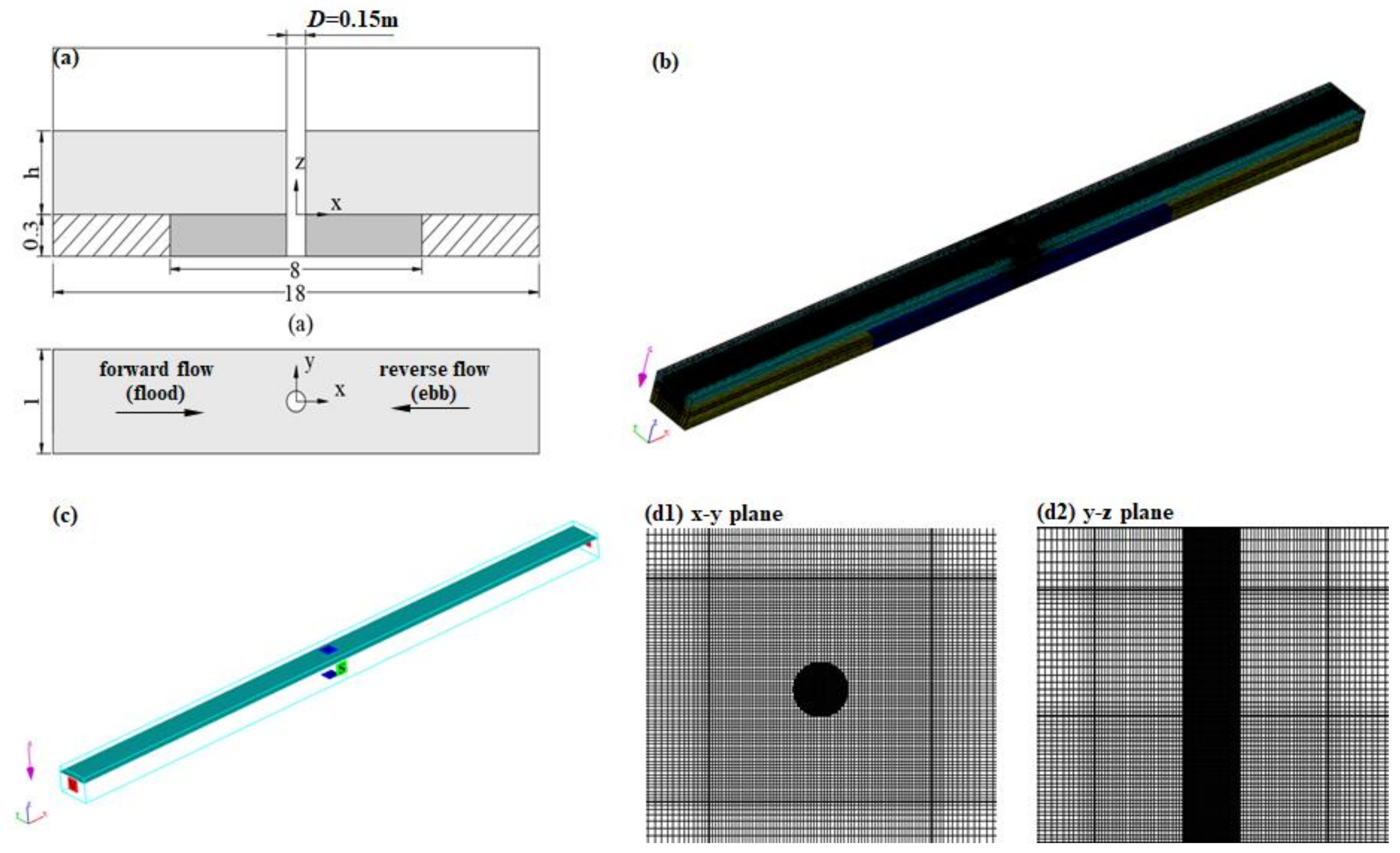

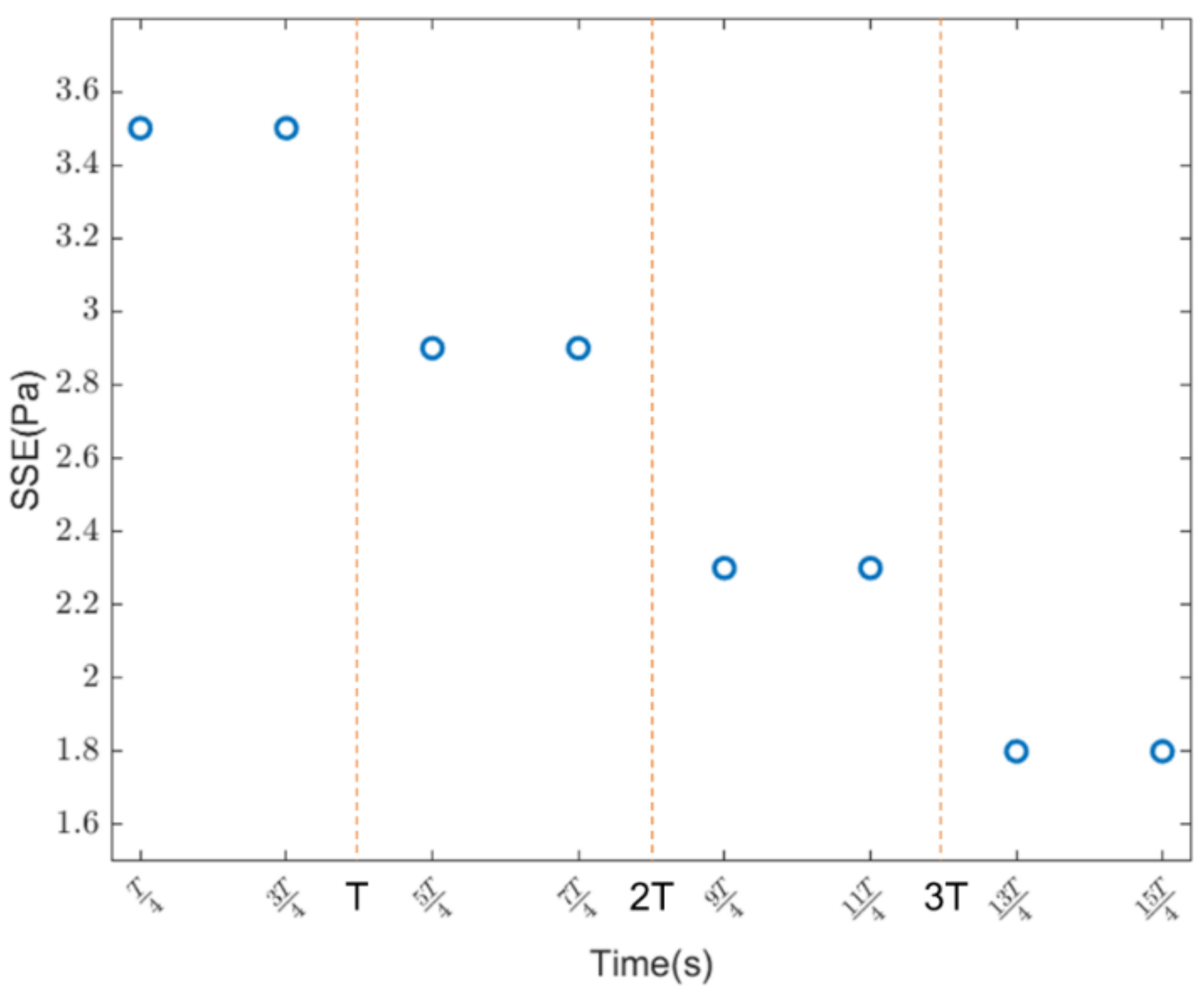
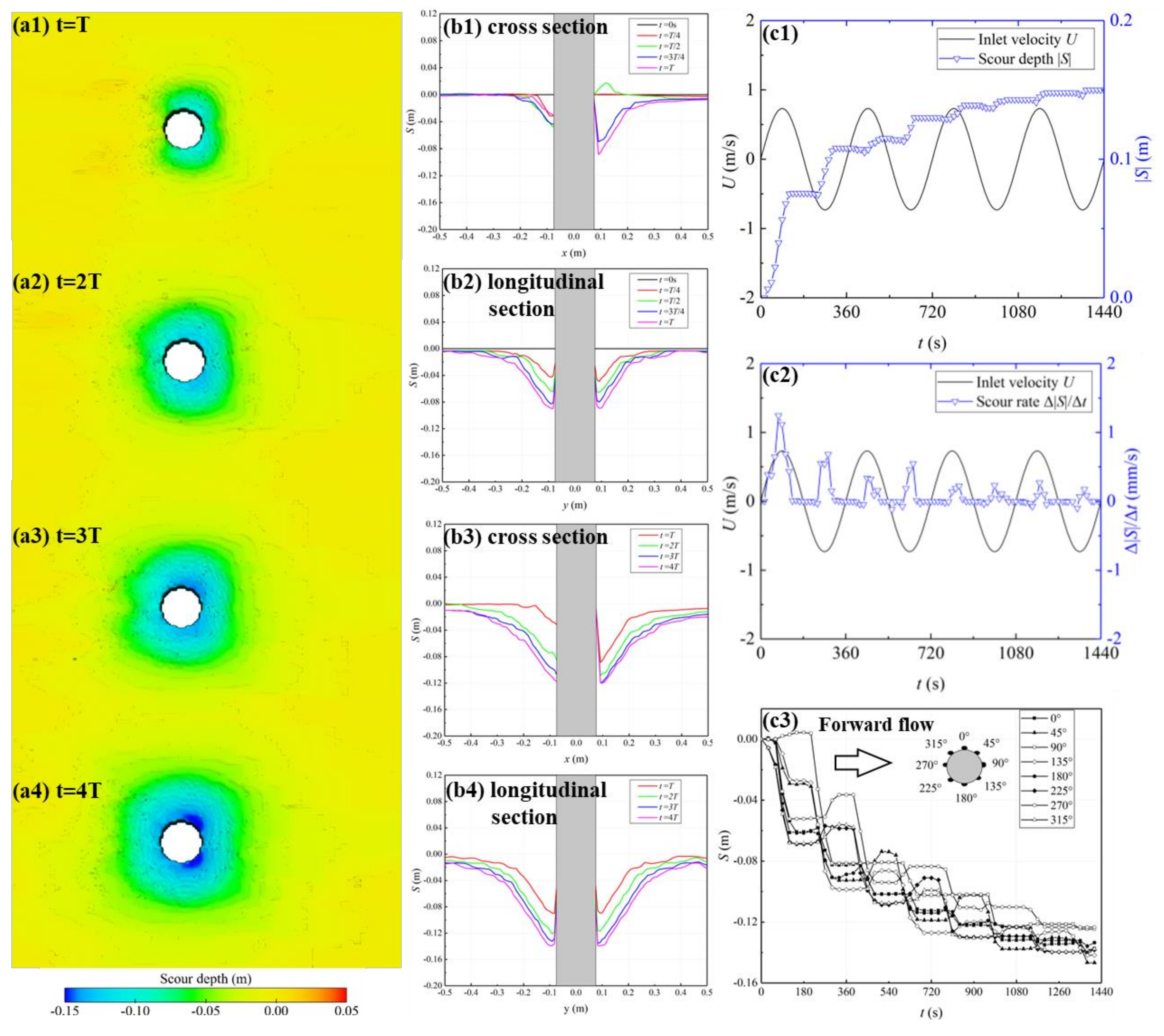
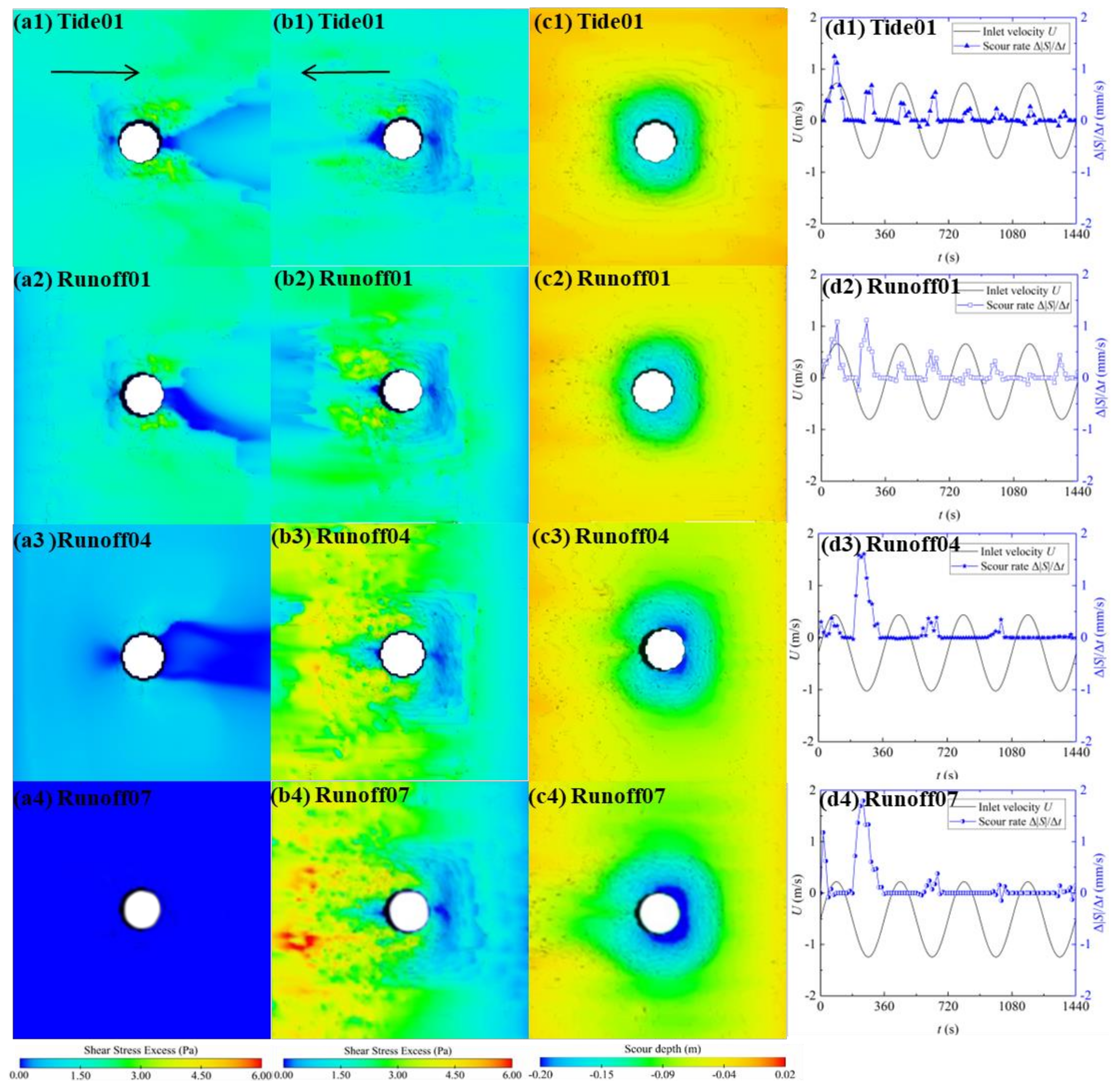
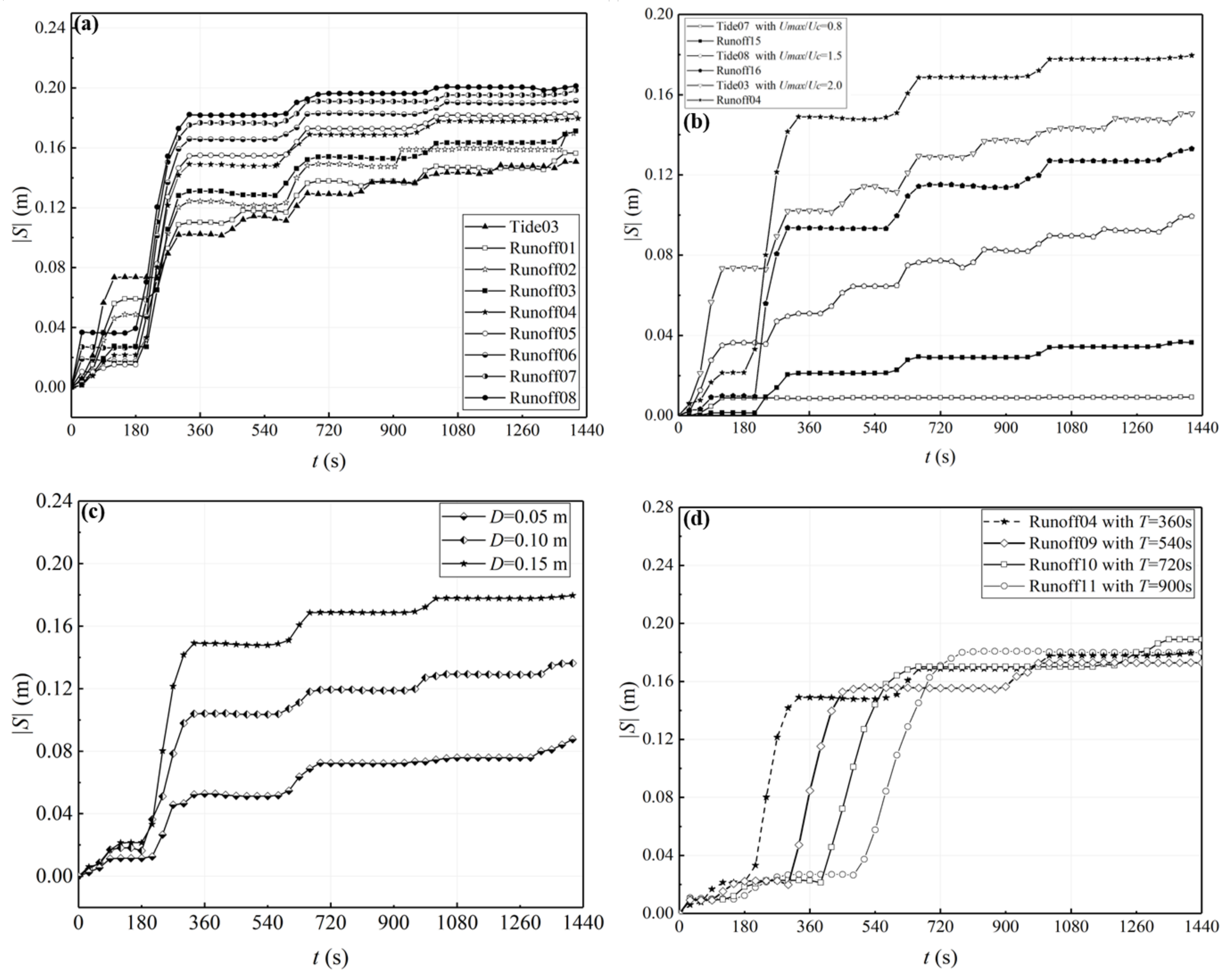

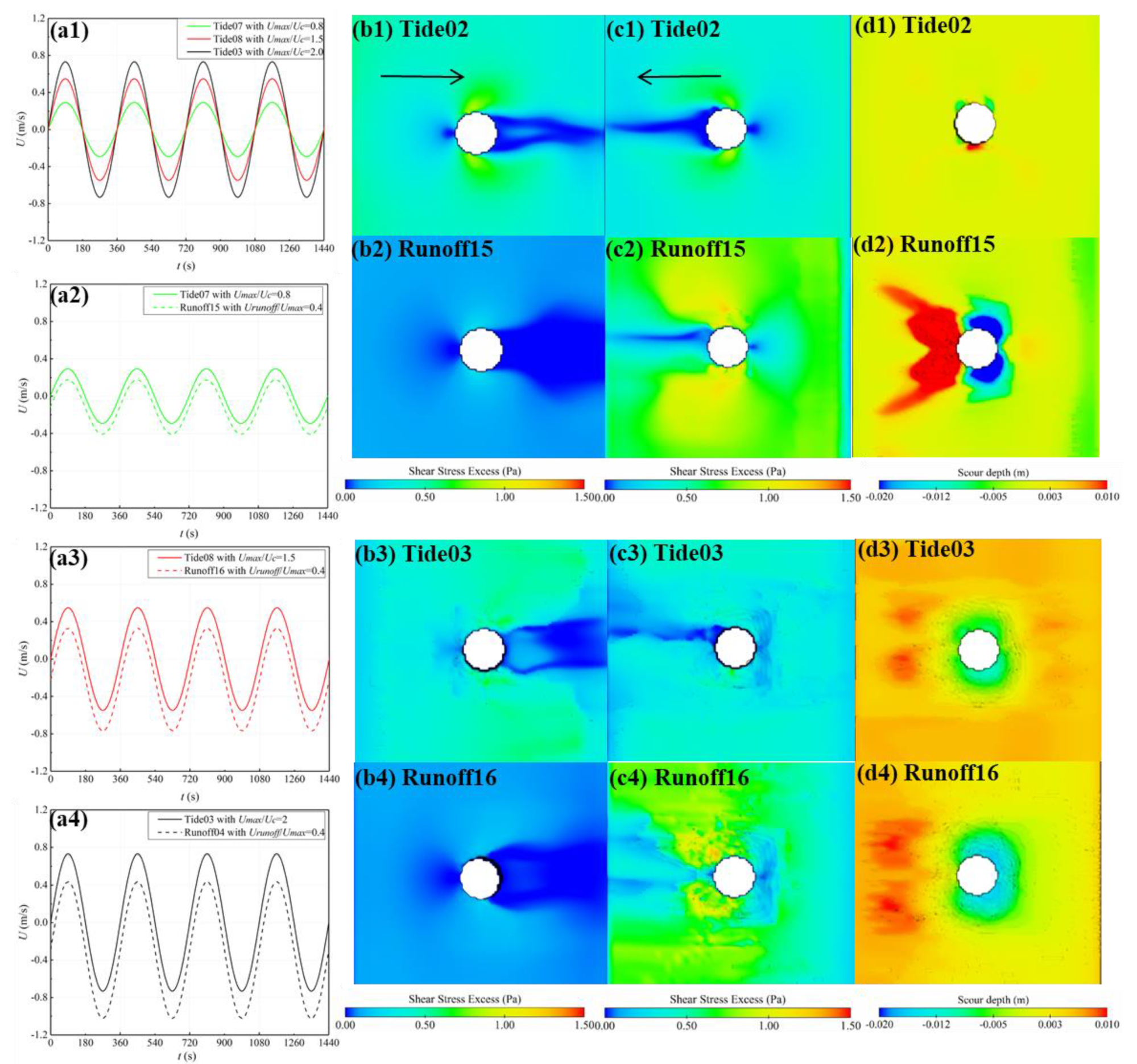
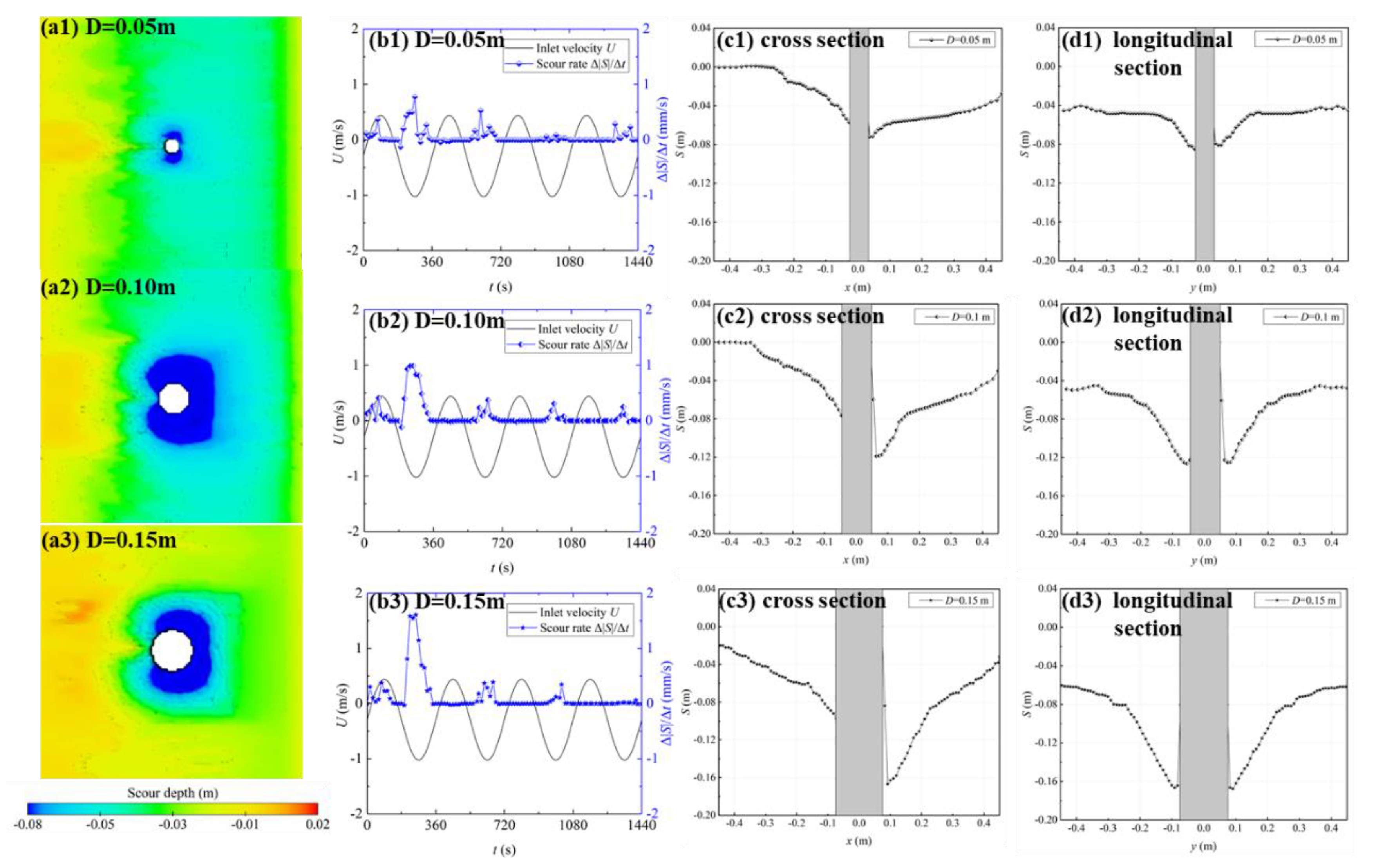
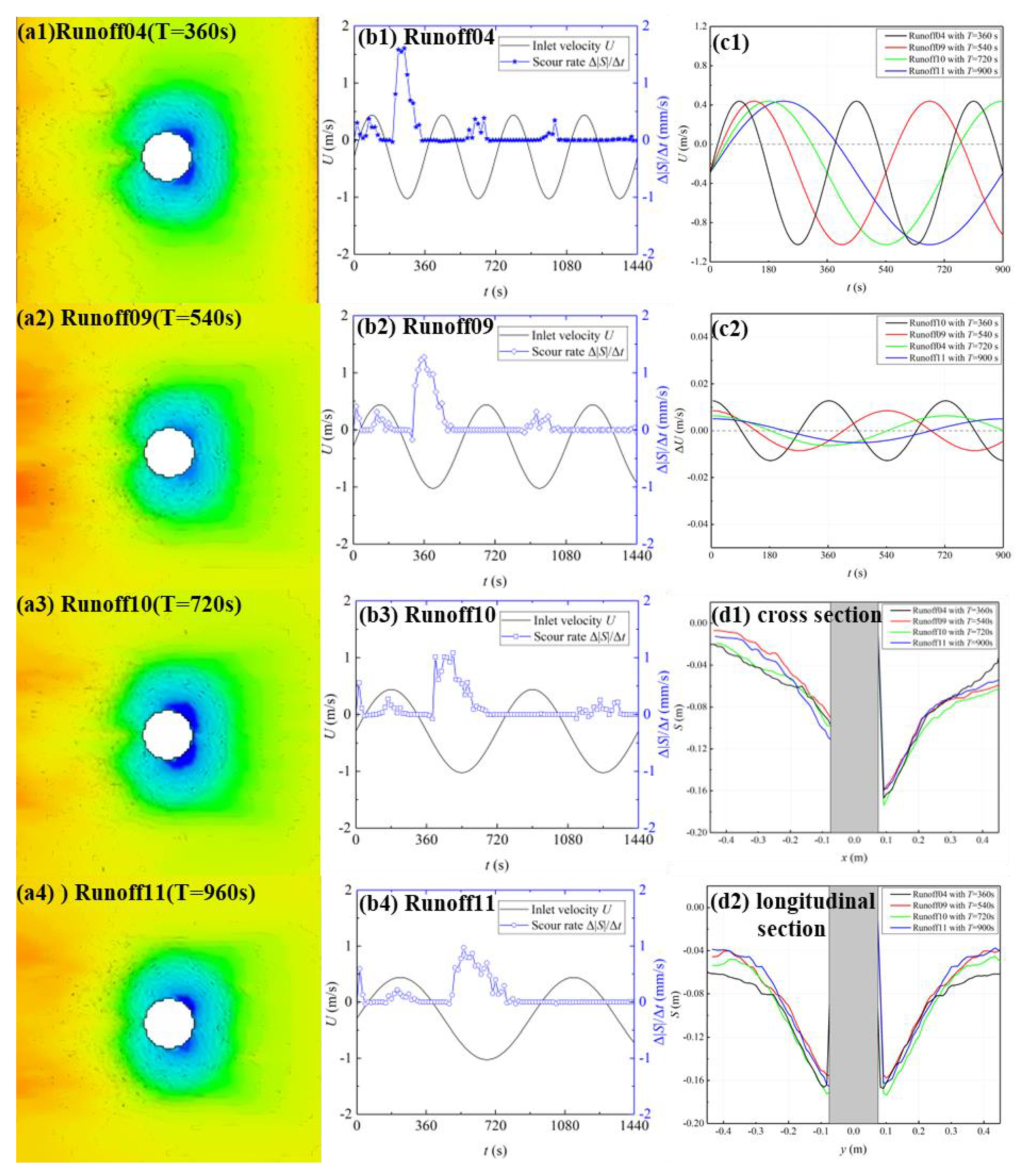
| Uc (m/s) | h (m) | Hs (m) | D (m) | d50 (mm) | ρ (kg/m3) |
|---|---|---|---|---|---|
| 0.366 | 0.45 | 0.3 | 0.15 | 0.75 | 2650 |
| Group 1: Tests for the local scour effect of reciprocating flow on a cylinder | |||||||||
| Test names | D(m) | h(m) | U(m/s) | Umax/Uc | Descriptions | ||||
| Tide01 | 0.15 | 0.45 | 0.732sin(2πt/T) | 2 | Influence of reciprocating flow on local scour | ||||
| Group 2–5: Tests for the local scour effect of a cylinder in different hydrodynamic conditions | |||||||||
| Test names | D (m) | T (s) | Umax (m/s) | Uuni (m/s) | Uuni/Umax | Umax/Uc | D/h | Re | Descriptions |
| Tide01(ibid) | 0.15 | 360 | 0.732 | 0.000 | 0.0 | 2.0 | 0.33 | 103,585 | Influence of river flow strength (compared with Tide01) Influence of peak tidal currents (Runoff04 compared with Tide01) |
| Runoff01 | 0.15 | 360 | 0.732 | −0.073 | 0.1 | 2.0 | 0.33 | 113,915 | |
| Runoff02 | 0.15 | 360 | 0.732 | −0.146 | 0.2 | 2.0 | 0.33 | 124,245 | |
| Runoff03 | 0.15 | 360 | 0.732 | −0.220 | 0.3 | 2.0 | 0.33 | 134,717 | |
| Runoff04 | 0.15 | 360 | 0.732 | −0.293 | 0.4 | 2.0 | 0.33 | 145,047 | |
| Runoff05 | 0.15 | 360 | 0.732 | −0.366 | 0.5 | 2.0 | 0.33 | 155,377 | |
| Runoff06 | 0.15 | 360 | 0.732 | −0.439 | 0.6 | 2.0 | 0.33 | 165,708 | |
| Runoff07 | 0.15 | 360 | 0.732 | −0.512 | 0.7 | 2.0 | 0.33 | 176,038 | |
| Runoff08 | 0.15 | 360 | 0.732 | −0.586 | 0.8 | 2.0 | 0.33 | 186,509 | |
| Runoff09 | 0.15 | 540 | 0.732 | −0.293 | 0.4 | 2.0 | 0.33 | 145,019 | Influence of tidal periods (compared with Runoff04) |
| Runoff10 | 0.15 | 720 | 0.732 | −0.293 | 0.4 | 2.0 | 0.33 | 145,019 | |
| Runoff11 | 0.15 | 900 | 0.732 | −0.293 | 0.4 | 2.0 | 0.33 | 145,019 | |
| Runoff12 | 0.05 | 360 | 0.732 | −0.293 | 0.4 | 2.0 | 0.11 | 48,340 | Influence of cylinder diameters (compared with Runoff04) |
| Runoff13 | 0.10 | 360 | 0.732 | −0.293 | 0.4 | 2.0 | 0.22 | 96,679 | |
| Runoff14 | 0.20 | 360 | 0.732 | −0.293 | 0.4 | 2.0 | 0.44 | 193,358 | |
| Tide02 | 0.15 | 360 | 0.293 | 0.000 | 0.0 | 0.8 | 0.33 | 41,462 | |
| Tide03 | 0.15 | 360 | 0.549 | 0.000 | 0.0 | 1.5 | 0.33 | 77,689 | |
| Runoff15 | 0.15 | 360 | 0.293 | −0.117 | 0.4 | 0.8 | 0.33 | 58,047 | Influence of peak tidal currents (compared with Tide02) |
| Runoff16 | 0.15 | 360 | 0.549 | −0.220 | 0.4 | 1.5 | 0.33 | 108,764 | Influence of peak tidal currents (compared with Tide03) |
| Time | Velocity (m/s) | SSE (Pa) |
|---|---|---|
| t = T/4 | 0.6 | 3.5 |
| t = 3T/4 | −0.5 | 3.5 |
| Maximum Scour Depth Point | Minimum Scour Depth Point | |
|---|---|---|
| Forward flow | 225° or 315° | 90° or 270° |
| Reversed flow | 45° or 135° | 90° or 270° |
Disclaimer/Publisher’s Note: The statements, opinions and data contained in all publications are solely those of the individual author(s) and contributor(s) and not of MDPI and/or the editor(s). MDPI and/or the editor(s) disclaim responsibility for any injury to people or property resulting from any ideas, methods, instructions or products referred to in the content. |
© 2025 by the authors. Licensee MDPI, Basel, Switzerland. This article is an open access article distributed under the terms and conditions of the Creative Commons Attribution (CC BY) license (https://creativecommons.org/licenses/by/4.0/).
Share and Cite
Xia, Y.; Liu, J.; Yang, S.; Wang, S.; Li, L. Scour Depth Around Cylinders Under Combined Effects of River Flow and Tidal Currents. J. Mar. Sci. Eng. 2025, 13, 1114. https://doi.org/10.3390/jmse13061114
Xia Y, Liu J, Yang S, Wang S, Li L. Scour Depth Around Cylinders Under Combined Effects of River Flow and Tidal Currents. Journal of Marine Science and Engineering. 2025; 13(6):1114. https://doi.org/10.3390/jmse13061114
Chicago/Turabian StyleXia, Yuezhang, Jiahao Liu, Shiyu Yang, Shaohua Wang, and Li Li. 2025. "Scour Depth Around Cylinders Under Combined Effects of River Flow and Tidal Currents" Journal of Marine Science and Engineering 13, no. 6: 1114. https://doi.org/10.3390/jmse13061114
APA StyleXia, Y., Liu, J., Yang, S., Wang, S., & Li, L. (2025). Scour Depth Around Cylinders Under Combined Effects of River Flow and Tidal Currents. Journal of Marine Science and Engineering, 13(6), 1114. https://doi.org/10.3390/jmse13061114






